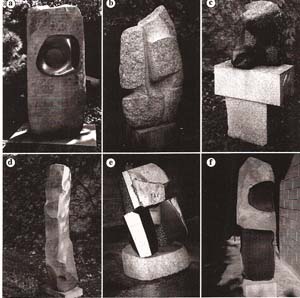Two years ago, with a book on sculpture gardens of the nation in hand, my husband, Patrick, and I embarked on a six-week adventure across the country. Our first stop was the University Sculpture Garden in Lincoln, Nebraska. Next were the Henry Moore collection in Kansas City, and the Laumeier Sculpture Garden in St. Louis. We crossed New York state on Route 17 as the maple leaves were changing color in the crisp fall weather. The call of the returning Canada geese punctuated our visit to Storm King and Kykuit, the Rockefeller collection. Among the many New York sculpture parks, the Isamu Noguchi Garden Museum is a dream come true! The museum, which opened in 1985 in Queens, brings together over 200 of Isamu’s finest sculptures. The scope of 60 years of intense sculptural activity is in view at a single location.

Isamu bought a photoengraving plant in 1975, a triangular space produced by dividing a city block diagonally. With the help of long-time friend, architect Shoji Sadao, Isamu designed an indoor/outdoor garden gallery. Windows are open permanently to the elements, and unexpected trees growing within add an element of surprise to the space. The garden reveals Isamu’s passion for nature and his desire to sculpt “space.” He effectively used Japanese elements while imprinting his own innovative expression on the garden. Where a traditional tsukuban collects water, his dispenses it. While Japanese gardens often contain stone in its natural form, Isamu displayed chiseled planes and textures and called them “bones of the earth.” White birch, black pine, juniper, katsura, ilanthus, magnolia and various bamboo contribute to an exquisite garden. Stones sculpted into irregular forms add a metaphor of his experience in the world. Ideally-placed voids balanced with solid mass, areas of smooth and rough, geometric and organic shapes — all express design perfection. He intended the stone to reflect the human condition and regarded stone as a source of consolation through its symbolic force of eternal variety.
Outstanding in the garden, Core (Fig.1a), is a 74" basalt sculpture on a granite base. Concerning this sculpture, Isamu reflected, “Sometimes out of despair when we have given up, the stone itself sends a message bit by bit. Finally everything falls into place with a precision so remarkable, it cannot be chance.” Of Indian Dancer (Fig.1b), a 60" pink granite sculpture, Isamu said, “ I was reminded of Balasarawathi, the great dancer of Bharatha Natyam whom I saw in Madras. With time, Indian Dancer has also gained the authority which was characteristic of her.” Seeking (Fig.1c), a 29" granite, “refers to the artist and also to the sculpture as an identity. What is its intention? Reflected is the difficulty and uncertainty of its making — its final resolution or catharsis.” Dance (Fig1d), is an 84" Manazura stone carving about which Isamu wrote, “carving follows the possibilities inherent to the stone. This collaboration is limited, but the other way is confrontation. Confrontation may lead to conquest, conquest over oneself, of course, not the stone. Art is more than a compromise: to override the inhibitions that blind.” Woman (Fig.1e), a 66" basalt , was “an abandoned sculpture suddenly come back to life,” he wrote. “Its true nature revealed, it now has left no doubt as to what it must be. My every decision came with an inevitability. An overcoming of hesitations.” Of Sculpture Finding (Fig.1f), a 77" basalt, he reflected “...the presumption to work as we do, comes from the ability of new tools to incise our will upon matter - like a meeting from the opposite ends of time to resume on another level the continuity that has gone on for years.”
On the first floor of the gallery, with its concrete floors and walls, beams of light peer through open windows, illuminating many of his larger sculptures. Heart of Darkness, a large black obsidian, its matrix of white skin and intense, gorgeous black interior, is transformed by the touch of Isamu. Nearby is To Intrude on Nature’s Way, superbly positioned on a wood/granite base. Isamu said “The art of stone in a Japanese garden is that of placement. Its ideal does not deviate from that of nature except in providing a heightened appreciation. Any man-made divergence is carefully hidden, as by the intercession of time and age, nature’s accidents and residue. But I am also a sculptor of the west. I place my mark and do not hide. The cross currents eddy around me. In To Intrude On Nature’s Way, the contradictions between the eastern and western approaches are resolved with a minimum of contrivance.”
The second floor, up wooden stairs, is an exquisite space with warm maple floors, skylights, and a feeling of floating. It houses Isamu’s smaller sculptures in stone, metal and wood. These smaller scale pieces evoke a more intimate response, but remain true to Isamu’s major themes: reference to and reverence for natural phenomena. For example, in Black Hills, the importance of landscape; in Seeker, variation; and in Vertical Man, the figurative presence. This space houses his early works which were influenced by Brancusi’s ceramic and metal sculpture. Also shown are Isamu’s sculptures based on Japanese culture, as well as his surrealist-inspired marble, slate and wood sculptures created during his self-imposed internment period in WWII. In addition, here is a replica of Isamu’s studio in Japan, models for his playground and garden designs, stage sets for Martha Graham and the Akari Lights of Gifu.
Until an opportunity arises to see the garden, the book The Isamu Noguchi Garden Museum (I. Noguchi. 1999. Abrams), is a well produced substitute for a personal visit. [Editor’s note: The biography Noguchi: East and West (D. Ashton. 1992. Univ. Calif. Press) is excellent.] I came away changed, humbled by Isamu’s lifetime achievements, energized and educated by his sense of design, and with a new respect for material and his brilliant treatment of bases. Most of all, I was awed by his unending and uncompromising search for the truth.

